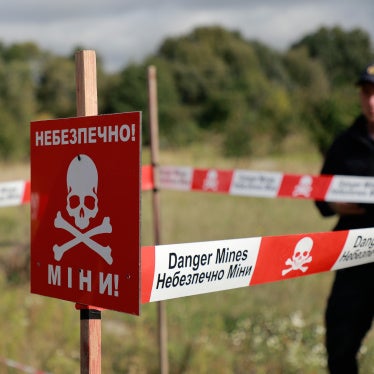Thank you Mr. Chairman.
Human Rights Watch is a founding member of the International Campaign to Ban Landmines, the Cluster Munition Coalition, the International Network on Explosive Weapons, and the Campaign to Stop Killer Robots. But today we will be speaking about incendiary weapons.
Incendiary weapons rank among the cruelest means of armed conflict. They burn through the flesh of their victims, causing excruciating pain. Initial injuries often lead to complications such as shock, infection, and asphyxiation. In addition to ongoing physical suffering, the individuals who survive frequently experience psychological harm, severe disfigurement, and social ostracization. Treatment is also painful, and one doctor likened having dead skin sloughed off to “being flayed alive.”
Despite the agony incendiary weapons inflict on civilians and soldiers alike, they have been used in several conflicts over the past decade. Most recently, Human Rights Watch has reviewed incendiary weapon attacks in Syria and allegations of use in Libya, Ukraine, and Yemen.
Over the past five years, many states have expressed concerns about incendiary weapons in First Committee, meetings of the Convention on Conventional Weapons (CCW), and other fora. They have condemned use and/or called for revisiting existing international law. But countries need to back up their statements with action. The combination of continued use of incendiary weapons and growing opposition to the harm they cause suggests that the time is ripe for change.
Protocol III to the CCW regulates incendiary weapons, most notably by restricting their use in concentrations of civilians. This instrument has two key shortcomings, however. First, it defines incendiary weapons as being “primarily designed” to burn, and thus it arguably excludes some munitions with incendiary effects—munitions that have been used for their incendiary effect—such as those containing white phosphorus. Adoption of a definition based on the effects, rather than the design, of the weapons would close this loophole.
Second, Protocol III has weaker restrictions for ground-launched incendiary weapons than for air-dropped ones. At a minimum, it should be amended to ban use of all incendiary weapons in concentrations of civilians. An absolute ban on the use of incendiary weapons would have the greatest humanitarian impact.
We urge all states to express their views on incendiary weapons at First Committee and at the meeting of CCW states parties in November. They should condemn the use of incendiary weapons in populated areas, including in Syria. They should also call for initiation of formal CCW discussions on incendiary weapons, with an eye to strengthening Protocol III.
States should aim to make tangible progress in addressing the problems of incendiary weapons at the Fifth CCW Review Conference, which will be held in Geneva next year. But states need to speak out now in order to lay the groundwork for action in 2016. In so doing, they can help ensure that this crucial opportunity to reduce the cruelty of war is not wasted.
Thank you.








